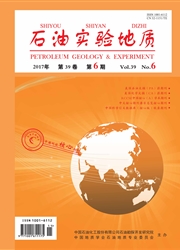

 中文摘要:
中文摘要:
依据对中国南方占油藏、沥青点、油气苗点和钻井盟示的统计,从油气成藏与破坏的基本地质因素出发,总结了南方海相油气藏破坏的糕本类型及其可能的分布范围。南方海相油气藏的破坏类型主要分为6种,即断裂切割破坏型、油减抬升破坏型、深埋裂解破坏型、岩浆作用破坏型、褶皱变动破坏型和流体冲洗破坏型,其中前4种类型分布最为广泛。该区油气藏破坏主要由构造变动引起盖层剥蚀或盖层有效性变差所造成,加里东末期的构造运动造成了下组合油气藏第一次规模性破坏;燕山期以来扬子周缘强烈的构造挤压,是四川盆地以外海相油气藏破坏的主要因素;燕山期发生在中下扬子、江南雪峰隆起以及滇黔桂地区厂、泛的岩浆侵入.是引起这些地区油气藏破坏的重要因素。
 英文摘要:
英文摘要:
According to statistics of destroyed hydrocarbon reservoir, natural asphalt, oil and gas seepage and evidence, with studies of basic geological factors which influenced hydrocarbon accumulation and destruction, it was summarized in this paper the destruction types and the distribution of marine hydrocarbon reservoirs in South China. The destruction of hydrocarbon reservoirs was divided into 6 types: fault-rupturing, reservoir-uplifting, cracking for deep subsidence, magmatic process, fold-alternating and fluid-washing, among which the former 4 types were common. The main factors for hydrocarbon reservoir destructions in the study area were erosions or invalidations of cap rocks caused by tectonic activities. At the end of the Caledonian Movement, the lower reservoirs were destroyed in large scale for the first time. Since the Yanshan Movement, fierce tectonic compressions had taken place around the Yangtze block, resulting in destructions for marine hydrocarbon reservoirs in South China except for the Sichuan Basin. Magmatic processes in the middle-lower Yangtze, the Jiangnan-Xuefeng Uplift as well as Yunnan, Guizhou and Guangxi Provinces during the Yanshan Movement caused reservoir destructions in the region.
 同期刊论文项目
同期刊论文项目
 同项目期刊论文
同项目期刊论文
 Formation mechanism of carbonate cemented zones adjacent to the top overpressured surface in the cen
Formation mechanism of carbonate cemented zones adjacent to the top overpressured surface in the cen 期刊信息
期刊信息
